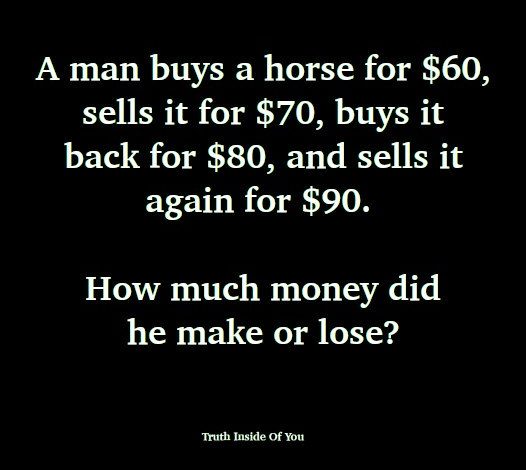
ADVERTISEMENT
The Horse Trading Puzzle: Unraveling the Profit or Loss
Puzzles involving simple arithmetic or logical reasoning often capture our attention because they seem straightforward at first glance, but they can be deceptively tricky. The puzzle presented in the image is a classic example of a financial transaction scenario that invites us to calculate a profit or loss. The scenario goes as follows:
- A man buys a horse for $60.
- He sells the horse for $70.
- He buys the horse back for $80.
- Finally, he sells the horse again for $90.
The question is, how much money did he make or lose? Let’s break down this transaction step by step and uncover the correct answer.
Understanding the Transactions
To solve this puzzle, we need to carefully analyze each step of the transaction and calculate the overall financial outcome.
- First Purchase and Sale:
- The man buys the horse for $60.
- He sells the horse for $70.
At this point, the man has made a profit of $10 because he sold the horse for $70 after buying it for $60. This transaction is straightforward: selling at a higher price than the purchase price results in a profit.
- Second Purchase and Sale:
- The man buys the horse back for $80.
- He sells the horse again for $90.
In this second set of transactions, he spends $80 to buy back the horse and then sells it for $90. Here, he makes another profit of $10 because the selling price exceeds the purchase price by $10.
Summing Up the Profits
Now, to determine the overall profit or loss, we simply add the profits from both transactions:
- First profit: $10
- Second profit: $10
The total profit made by the man is $10 + $10 = $20.
ADVERTISEMENT
Thus, the man made a profit of $20 through these transactions.
Why This Puzzle Can Be Confusing
This puzzle can be confusing because it involves multiple transactions that appear to cancel each other out. Some people might mistakenly think that since the man bought and sold the horse twice, he should have broken even. However, the key is to focus on the profit or loss from each individual transaction rather than trying to aggregate the transactions into a single calculation.
Additionally, the wording of the puzzle can sometimes lead to overthinking. The puzzle presents a scenario with simple math, but the sequence of buying and selling creates a situation that seems more complex than it actually is.
Real-World Applications: Understanding Profit and Loss
This puzzle is more than just a fun brain teaser; it also has practical implications for understanding profit and loss in real-world business transactions. Whether in stock trading, real estate, or simple buying and selling, the principle remains the same: profit is made when the selling price exceeds the purchase price, and loss occurs when the purchase price exceeds the selling price.
In the world of finance and business, this type of calculation is fundamental. The puzzle serves as a reminder that no matter how complex a series of transactions might seem, the key to determining financial outcomes lies in breaking down each step and calculating the net result.
ADVERTISEMENT
The Psychological Aspect: Why We Overcomplicate Simple Problems
Puzzles like this also highlight a psychological aspect of problem-solving: the tendency to overcomplicate what should be a straightforward calculation. The structure of the puzzle, with its repeated buying and selling, can make it feel more intricate than it is. This is a common cognitive bias known as complexity bias, where we assume that solutions must be complex when, in reality, they are often simple.
In educational settings, puzzles like this can be valuable tools for teaching students how to approach problems methodically and avoid overthinking. By focusing on each step individually, students learn to dissect problems into manageable parts and apply basic arithmetic or logic.
Conclusion: The Simple Answer to a Seemingly Complex Puzzle
In conclusion, the man in the puzzle made a clear profit of $20 through his transactions. By selling the horse for more than he bought it on both occasions, he successfully increased his wealth. This puzzle not only serves as an engaging brain teaser but also reinforces important concepts in finance, logic, and problem-solving.
Understanding how to break down complex-seeming problems into simple steps is a valuable skill, both in academic pursuits and real-life financial decisions. The key takeaway here is that careful analysis of each transaction reveals that even puzzles with multiple steps can often be resolved with basic arithmetic and logical reasoning.
Keywords: profit and loss, financial transactions, puzzle solving, logical reasoning, problem-solving, cognitive bias, complexity bias, arithmetic, financial education, brain teasers, horse trading puzzle.
ADVERTISEMENT




